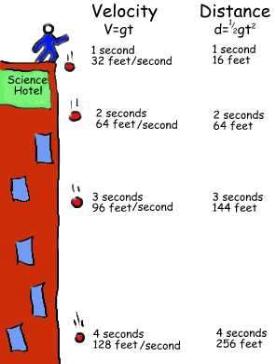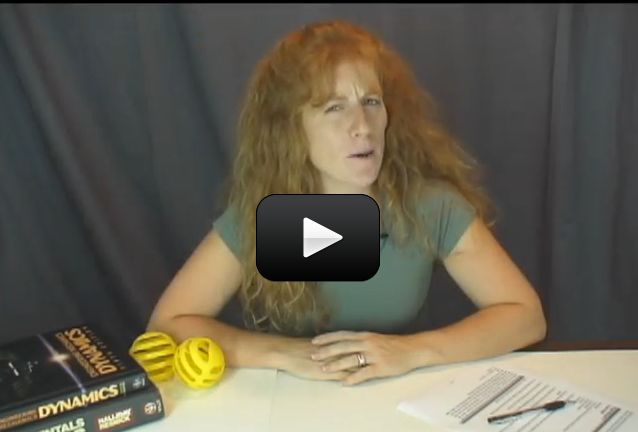You have just taken in a nice bunch of information about the wild world of gravity. This next section is for advanced students, who want to go even deeper. There’s a lot of great stuff here but there’s a lot of math as well. If you’re not a math person, feel free to pass this up. You’ll still have a nice understanding of the concept. However, I’d recommend giving it a try. There are some fun things to do and if you’re not careful, you might just end up enjoying it!
Here’s what you need:
[am4show have=’p8;p9;p11;p38;p38;p92;’ guest_error=’Guest error message’ user_error=’User error message’ ]
- ball
- pencil, paper
- stopwatch
- yardstick or tape measure
Download Student Worksheet & Exercises
Okay, let’s see where we can go here. Gravity accelerates all things equally…what does that mean? All things accelerate at 32 feet per second squared due to gravity. In metric, it accelerates 9.8 meters per second squared.
What that means is, every second something falls, its speed increases by 32 feet/second or 9.8 meters/second. Believe it or not, that’s about 22 miles per hour!! Gravity will accelerate something from 0 to 60 mph in about 3 seconds. Faster then all but the fastest sports cars!
So what is acceleration anyway? Well speed is the amount of distance something travels in a certain amount of time. Five miles per hour, for example, tells you that something can travel five miles in an hour. Acceleration is how much the speed changes over time. So acceleration would be miles per hour per hour or feet per second per second.
Acceleration is a rate of change of speed or, in other words, how fast is the speed is changing. Feet per second per second is the same as ft/s/s which is the same as ft/s². (I told you we were going deeper!) Let’s say you’re riding your bicycle at a positive acceleration (your getting faster) of 5 ft/s².
That means in 1 second you’re moving at a speed of 5 ft/s.
After 2 seconds you’re moving at a speed of 10 ft/s.
After 3 seconds you’re now clipping along at 15 ft/s (about 10 mph).
 So you can see that as long as you accelerate, you will be getting faster and faster. The formula for this is v=at where v is velocity, a is acceleration and t is time. (We will be doing more with acceleration in a future lesson.)
So you can see that as long as you accelerate, you will be getting faster and faster. The formula for this is v=at where v is velocity, a is acceleration and t is time. (We will be doing more with acceleration in a future lesson.)
If we want to find out how fast something is going after it has been dropped, we use the formula v=gt. The letter “v” stands for velocity (which basically means speed.) “g” stands for the gravitational constant and “t” stands for time.
If we want to find out how fast a golf ball is dropping after it falls for 3 seconds we multiply 3 seconds by 32 feet/second squared and that equals 96 feet/second. So, if I dropped a golf ball off a building, it would be going 96 feet per second after 3 seconds of dropping.
The formula looks like this when we fill in the numbers:
v=3s x 32 ft/s²
If we do more math, we’ll see that after one second something will be item7going 32 ft/s, after 2 seconds it will be going 64 ft/s, after 3 seconds 96 ft/s after 4 seconds 128 ft/s. Get it? Anything dropped will be going that speed after that many seconds because gravity accelerates all things equally (air resistance will effect these numbers so you won’t get exactly the numbers in practice that you will mathematically).
All right, lets go even deeper. We now know how to calculate how fast something will be going if it is dropped, but what happens if we throw it up? Well, which way does gravity go? Down right? Gravity accelerates all things equally so, gravity will slow things down as they travel up by 32 ft/s². If a ball is thrown up at 64 ft/s how long will it travel upwards? Well, since it is negatively accelerating (in physics there’s no such thing as deceleration) after the first second the ball will be traveling at 32 ft/s and after 2 seconds the ball will come to a stop, turn around in midair, and begin to accelerate downwards at 32 ft/s². Using this, you can tell how fast you can throw by using nothing more then a timer. Let’s try it.
For this experiment, you will need:
– A ball (a tennis ball or baseball would be perfect)
– A stopwatch
– Pencil and paper
– A friend
– A calculator
1. Go outside and pick one person to be the thrower and another to be the timer.
2. Have the timer say “Ready, Set, Go!” and at go he or she should start the stopwatch.
3. When the timer says go, the thrower should toss the ball as high as he or she can.
4. The timer should stop the stopwatch when the ball hits the ground.
5. Write down the time that the ball was in the air.
6. Let each person take a couple of turns as timer and thrower.
7. Now, come back inside and do a bit of math.
Ok, let’s see how you did. Let’s say you threw the ball into the air and it took 3 seconds to hit the ground. The first thing you have to do is divide 3 in half. Why? Because your ball traveled 1.5 seconds up and 1.5 seconds down! (By the way, this isn’t completely accurate because of two things. One, air resistance and two, the ball falls a little father then it rises because of the height of the thrower.) Now, take your formula and figure out the speed of the throw.
v=gt,
so v=32 ft/s² x 1.5 sec or
v = 48 ft/s.
So, if that’s how fast it left your hand…how fast was it going when it hit the ground? Yup, 48 ft/s. It has to be going the same speed because it had just as much time to speed up as it had to slow down, 1.5 seconds. Try that with your time and see how fast your throw was.
Ok, hold your breath, just a little deeper now. Let’s talk about distance. If something starts from rest you can tell how far it drops by how long it has dropped. This formula is d=1/2gt² or distance equals one half the gravitational constant multiplied by time squared. Let’s try it. If I drop a ball and it drops 3 seconds how far has it dropped?
d=1/2 32ft/s² x (3s)² or
d = 16 ft/s x 9s² or
d=144 ft So it has dropped 144 ft.
Now try this with your time. What’s the first thing you have to do? Divide your time in half again, right. It took your ball half the time to go up and half the time to come down. Now plug your numbers into 1/2gt² and find out how high you threw your ball! Is Major League Baseball in your future?!
Advanced students: Download your Fast Ball Lab here.
Exercises
- Is gravity a speed, velocity, or acceleration?
- Does gravity pull equally on all things?
- Does gravity accelerate all objects equally?
- How is acceleration different from speed and velocity?
[/am4show]

